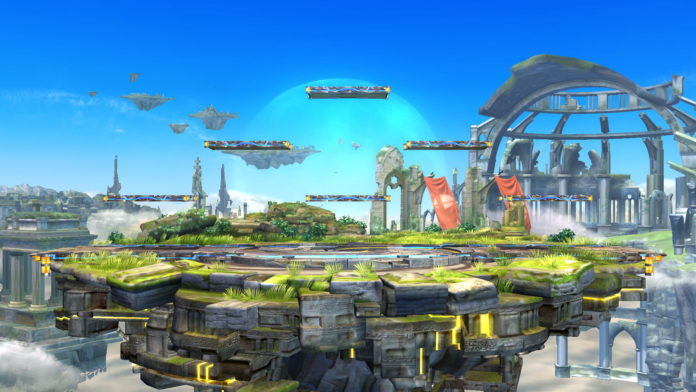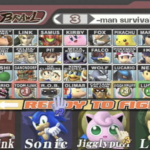Anyone who’s played Super Smash Bros. knows about the chaotic fun of that fighting game; multiple characters on screen, all sorts of items being thrown around, explosions galore, all taking place on a wide variety of colorful and hectic maps.
While this makes for great casual fun, tournament and competitive play for Super Smash Bros. looks for ways to strip away all the “random” elements of the game to make it as true a contest of pure skill as possible. Removing items was an easy fix; figuring out what stages to include in tournaments is a bit harder to pin down.
Let’s take a look at how stages and counterpicks are chosen for competitive play, and how shifting perspectives and the meta evolving over time can affect a stagelist.
What Makes A Stage Legal For Smash Bros. Tournaments?
Similar to the argument against items, players generally want to reduce the amount of “random” elements in a stage used for competitive play. This can involve hazards that pop up occasionally during a match that could damage one of the characters, or changes in the layout of the stage that drastically change how the match is played.
Unlike traditional fighting games, stages have a huge impact on how competitive Smash matches play out. It can drastically change how a matchup is played, and holding the counterpick advantage in a set can put a lot of pressure on the opponent.
This is the balance of choosing a good stagelist for tournaments; you want a variety of stages that each offer something a little different, but you don’t want any one stage having a significant advantage so that it becomes an overbearing presence in the meta. Players tend to dislike the feeling that they’re fighting the stage more than their opponent.
Because of this, and to allow for some strategizing in what stages are picked and played on in a set, stagelists in Smash tournaments are divided into “neutral” and “counterpick” categories. Neutrals tend to be stages with a relatively simple and fixed layout, with blast zones that aren’t too big or too small, whereas counterpick stages can have a little more volatility with in terms of their structure and how easy or difficult it is to get KO’ed.
Neutrals Versus Counterpicks
An old meme in the Smash community was “No items, Fox only, Final Destination” used to poke fun at how hardcore Smash players who strip the game down to these hazardless essentials. Final Destination, being a completely flat stage with no platforms, is often viewed as the quintessential competitive stage. However, that view has changed over the years.
Neutral stages in competitive play are the maps where the first game of every tournament set is played. A ruleset will include a handful of neutral stages, and the players in a set will arrive at a neutral stage through a process called “stage striking.”
A good neutral stage will have a relatively benign layout; not too big or small, maybe some platforms, blast zones that aren’t too close or far away from the stage. The stage should contribute to the dynamic combat of Super Smash Bros. without providing a clear advantage for a set of particular characters or tactics. A good neutral stagelist will try to include a variety of neutral stages, and rulesets avoid including stages that are redundant.
A counterpick stage is a stage available for the loser of a match within a tournament set to potentially have the advantage in the next match. These stages are given a little more leeway in terms of how their layouts are constructed, and where the blast zones are located. Again, counterpicks can’t be too egregious (we want the focal point of the match to be the interacting of the two players, not how they survive on a certain stage) but the idea is that the volatility of a counterpick stage can be an option for players; risk it big on a tougher stage and you can potentially turn the set around.
Of course, forcing players to play on counterpicks would often just be handing an automatic win to an opponent. This is why rulesets often include “stage bans” in between matches, in which case the winner of the previous match can choose one stage from the neutral + counterpick list to ban and avoid playing on for the next match.
Stages Through The Ages
The discussion of what stages should be legal for tournaments has spanned decades and several Super Smash Bros. games, and under no illusions should we consider the debate “solved.” There are still many things to consider when choosing a stagelist of suitable neutrals and counterpicks: what makes a stage fit into either category? How many stages should there be? How far do we want our stagelists to go?
Players today would be shocked and horrified at what stages were used in tournaments even a decade ago. There have been counterpicks with walk-offs, water hazards, moving floors, blast zones that shift, and even the entire map flipping. It’s important to remember that more moderate stagelist is the result of years of experimenting with different stages. You want a diverse stagelist to keep things fresh, to provide diversity and opportunity for players and characters, and to avoid the stagnation of only playing on a couple of maps.
Much of the debate around stage legality in Super Smash Bros. takes place in the counterpick category. This is where a difference of philosophy towards what a stage should be takes center stage, and oftentimes different regions around the world will have their own stagelists curated by their local communities.
Players who tend to prefer neutral stages will vote for extremely conservative limits on what a counterpick stage can bring to the table, since they believe a stage should interfere as little as possible in the interactions between two players.
Another school of thought from people who prefer more “volatile” counterpick stages is that, outside of random elements and overcentralizing aspects of a stage, a counterpick stage can and should provide more dynamics to a tournament match. Smash is a game where stages matter, and counterpick enthusiasts believe that stages can push this aspect of the game more aggressively without compromising competitive integrity.
Major tournaments are trending towards slightly more conservative stagelists and counterpicks, but you can find a wide variety of stage choices if you look at the different rulesets of regions all over the world. The debate around counterpicks is still very much alive, and tournament organizers will continue to test and push to see what stages have a home in competitive play.
The Perfect Stage
When it comes to competitive Smash, no stage will ever be the perfect map for tournament play. Every layout can offer advantages and disadvantages for the wide variety of characters in each game. Because there is no template for a “perfect stage,” it comes down to providing a balance of different stages that never tilt too far to benefit any one character or playstyle.
The best you can look for is stages that allow competitors to test their skill against one another, while also adding some of the unique taste that maps bring to the gameplay in Super Smash Bros. These games are unique in how the stage can play a role in the fight; it’s just about making sure you find that perfect balance.











